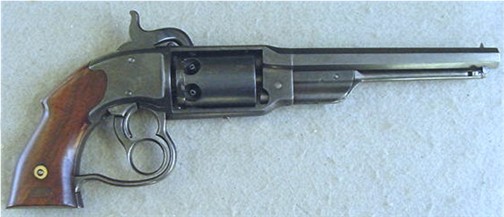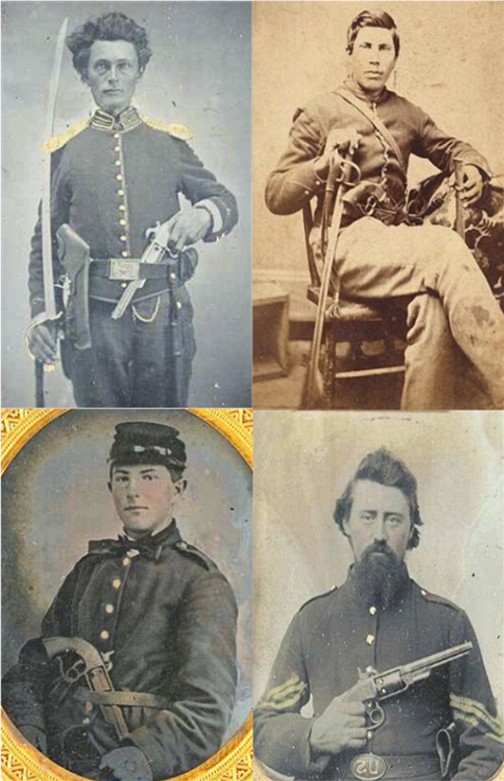|
SAVAGE REVOLVING FIRE-ARMS COMPANY “NAVY” MODEL
.36 CALIBER REVOLVER – EXCELLENT HIGH CONDITION EXAMPLE
OF ONE OF THE MOST MECHANICALLY INNOVATIVE PERCUSSION
REVOLVERS OF THE CIVIL WAR: Distinguished by
its unique profile and advanced design, the Savage
R.F.A. Company’s Navy Model .36 caliber Revolver was one
of the most mechanically innovative percussion pistols
which saw service during the American Civil War.

While the designation “Navy” conformed to the vernacular
of the period, referring to the .36 caliber – as opposed
to “Army”, the .44 caliber pistols – in fact, Savage
supplied these revolvers to both the U.S. Navy and U.S.
Army. Some 26 regiments of federal cavalry were issued
the Savage Navy Revolvers, and at least four Confederate
units were armed with them as well.

Manufactured by one of our country’s oldest gun maker
firms, the design of this revolver stemmed from the
initial patent issued in 1856 to Henry S. North for a
“Figure 8” revolver which featured a toggle mechanism
operating a longitudinal moving cylinder which seated
the face of the cylinder against the barrel, creating a
gas seal between the chamber and the barrel when the
pistol was fired.
Henry James North came by
his firearms acumen naturally as the grandson of the
famous Simon North who is credited with the invention of
the first practical milling machine in the early 1800’s
which was then applied to the manufacture of universally
interchangeable gun parts within a given model of
firearm – a significantly important benefit to the armed
forces.
The Savage-North relationship was created when Simon
North partnered with his brother-in-law, Josiah Savage
in 1811. After a series of management evolutions, in
1859 the Savage Revolving Fire-Arms Company was formed
with Josiah Savage’s son Edward serving as president,
and Henry North in their employ. That this revolver is
referred to as the “North-Savage”, or “Savage-North”, or
“Savage” in different modern references and listings is
due to the pistol’s combined lineage of North’s patent
and the Savage manufacturing company.
The final design of a series of ring/lever pistols which
were produced employing North’s “Figure-8” design, this
.36 caliber, 6-shot Savage Navy Revolver has a 7 1/8”
octagonal barrel and features a unique finger-ring
cocking lever in addition to the standard trigger, both
protected by a heart shaped trigger/lever guard. At
rest, the face of the cylinder is held against the rear
of the barrel whether the hammer is lowered on a cone or
at full cock.
To operate the revolver, the soldier would first pull
the ringed lever. This single pull retracted the
cylinder to the rear - allowing enough clearance for the
cylinder to rotate and advance the next chamber to index
with the barrel - and at the same time cocked the
hammer. When the ringed lever was released, the
cylinder returned forward “in battery”, seating the face
of the cylinder against the rear of the barrel creating
a gas seal. The pistol was then ready to be discharged
by using the traditional trigger.
The purpose of the “traveling” cylinder was to create a
gas seal to eliminate the loss of gasses produced by the
burning powder charge. Capturing the gasses retained
more of the resulting pressure and hence increased the
velocity of the bullet as it passed into the barrel.
This design feature was a marked improvement over the
gap between the cylinder and barrel which existed in
other designs such as Colt, Remington, et al.
While the mechanism is certainly more complicated than
most of the other revolver designs of the period, and
the larger protective trigger/ring lever guard was
somewhat unwieldy, with the onset of the Civil War the
demand for revolvers to arm the growing ranks of the
army guaranteed that any viable supply of revolvers was
absorbed into the nation’s arsenal. Beginning as early
as 1862 and on through the course of the war, the
federal cavalry regiments armed with Savage Navy
Revolvers included the Illinois 6TH, 10TH
and 13TH; Kansas 5TH and 15TH;
Kentucky 11TH; Missouri 3RD, 4TH
and 7TH; New York 7TH; Ohio 3RD;
Pennsylvania 7TH; the Potomac Brigade;
Wisconsin 1ST and 2ND; and Vermont
1ST. Missouri State Militia Cavalry
Regiments - 1ST through the 9TH,
and the 14TH - also received issues of these
revolvers.
It is worth noting that surviving records indicate that
at least some Savage Navy Revolvers were in the
inventory of Confederate cavalry regiments – the Texas
11TH; Virginia 7TH; and the 34TH
and 35TH Virginia Cavalry Battalions.
This specimen of the Savage R.F.A. Company “Navy”
Revolver has survived in excellent condition. Very
attractive and with all of the martial inspector’s
marks, this revolver presents in far better condition
than those that normally appear on the market.
This revolver features all matching serial numbers –
8745. In the context of the estimated full production
of 20,000, this is a fairly low serial number,
indicating it was produced in one of the earlier
production runs. The matching serial numbers are
stamped on the bottom flat of the barrel, the rear face
of the cylinder, the side of the grip frame under the
grip panel, and on the inside surfaces of both grip
panels.
The top flat of the frame retains the typically lightly
struck, but fully legible, maker’s stamping:
SAVAGE R.F.A. Co. MIDDLETOWN .
CT
H.S. NORTH PATENTED JUNE 17,
1856
JAN. 18, 1859, MAY 15, 1860
The mechanics function exactly as designed, with no play
and as tight as the day the pistol was manufactured.
The ring lever has a strong smooth pull which properly
retracts, advances, and returns the cylinder into
battery as it should, and with the same pull brings the
hammer to full cock. The main trigger-hammer function
is also very crisp.
The bore is as close to mint condition as one could
expect to find. The rifling is strong and distinct with
sharp edges, and no pitting or evidence of wear. The
six chambers of the cylinder are in likewise “like new”
condition with no pitting or signs of every having been
loaded. In fact, the pristine condition of the bore and
the chambers shows no indication that this revolver was
ever loaded or fired.
It is generally accepted that
Savage Navy Revolvers commonly present with heavily
worn, peened or broken percussion cones, more so than
generally found on other models of percussion
revolvers. Perhaps this damage was a function of the
angle of the hammer fall and force of the main spring.
So it is quite notable that all six of the original
percussion cones on this revolver are present, full
form, and show none of the peening or misshaping that is
typically found on these pistols.
The original loading lever is present and intact, and
operates as it should, as well as properly engaging the
loading lever latch on the underside of the barrel.
The two grip panels are in excellent, almost “like new”
condition – perhaps two of the best examples of original
Savage Navy Revolver grip panels in private hands.
Considerably thinner than
the grips of other Civil War era revolvers, these grip
panels were more inclined to suffer from exposure and
wear, and were subject to cracking, splitting or being
replaced altogether. This pair of panels, both serial
numbered to this revolver, have survived in amazing
condition. Showing only very minor handling marks, the
panels retain a very smooth surface with all of the
original finish intact, and most importantly, both grip
panels retain crisp, fully legible inspectors’
cartouches – “HBT” on the left grip panel for Henry B.
Thomas, and “RHKW” for then Lieutenant Colonel Robert
Henry Kirkwood Whiteley, U.S. Army Ordnance Department.
The metal components of the revolver are likewise
legibly stamped with the initials of the U.S. Army
inspectors who accepted the various parts as they were
viewed during the manufacturing process.
From all appearances, this revolver presents today as if
it were manufactured, inspected, and transferred to the
army’s inventory, and then for whatever reason was never
issued and certainly never exposed to the rigors of
field use. All of the edges are sharp, there is no
significant pitting or other signs of exposure, and
there is no evidence of holster wear. The metal retains
an even bright blue finish overall, with enough wear to
at the corners and sharp edges to suggest the finish is
quite old and is certainly not the result of an amateur
modern refinishing effort. The sharp edges show no
indication the metal was subjected to polishing after
the revolver was assembled and accepted by the army.
The blued finish is present on the hammer and ring lever
which on standard production revolvers were finished
with case colors. There is no doubt this Savage “Navy”
was a protected specimen, and it is possible it was
provided with a special full blued finish for
presentation, or it was refinished with this blue finish
long ago as part of the original owner’s maintenance
efforts. Other than the lack of case colors on those two
components, the blue finish overall is quite striking
and is consistent with the high condition of the grip
panels and the mechanical integrity noted above.
This is truly a rare and outstanding example of the
Savage “Navy” Revolver.
The finish, military inspection stamps, crisp mechanical
function and the spectacular grip panels combine to set
this Savage Navy Revolver in a class of it own. It
would be very difficult to find a better example, and
once this revolver has been added to your collection
there will be no need to attempt to up grade this
specimen. This Savage Navy Revolver could well be the
centerpiece of your Civil War pistol collection.
SOLD
|

